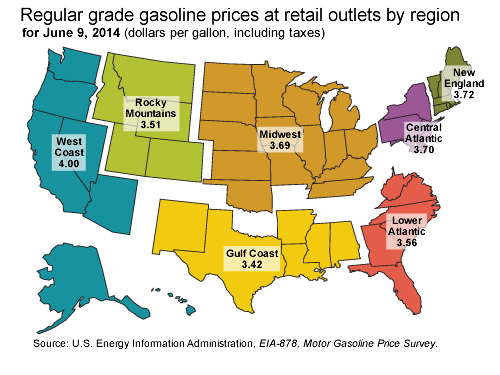

Not as Bad News: Most gasoline contains 10% or less ethanol (E-10). Thus, as this high cost ethanol is blended with gasoline, most people could be paying ~7¢ per gallon more when they fill up.
Better News: The current "price premium" between wholesale ethanol and gasoline has not existed for the entire year. From March to May, ethanol prices (green line) were less than gas. On a year-to-date basis, the price premium for E-10 is ~1.5¢ per gallon.
Hopeful Consumer News: U.S. ethanol inventories remain at near record high levels (excess supply). If inventories remain high, the current price premium may never fully make it to consumer's pocketbooks. Rather, ethanol companies may have to "eat" some of this higher cost, reducing their margin and profit levels to sell product.
What's Going On?: Prior to June, ethanol prices were trending lower in expectations of reduced ethanol feedstock costs from the largest corn crop planted in the U.S. since 1937. However, recent drought conditions in many mid Western States have caused commodity corn futures prices to skyrocket.
Currently, almost all ethanol in the U.S. is produced from corn feedstock. Until the Industry transforms itself to next generation feedstocks (e.g., sugar cane, sweet sorghum, cellulosic sources as is being done in Florida), ethanol prices will be highly dependent on the market price of corn. (1) (2)
Data Sources: -- Wholesale Ethanol prices (pink line) are from the Chicago Board of Exchange.
-- Real Time Daily Trading Data on energy products.

(2) "Corn Feedstock Cost" is the estimated "Net Costs" reflecting co-product of DDGS (Distiller Grains). The calculation methodology is simplistic, using 70% of commodity corn prices.
Per numerous Sources (DOE, EPA), E-10 (10% ethanol) has ~3% less efficiency than E-0 (zero ethanol). Ethanol on a "net basis" has less BTU content, but higher octane.
-- Wholesale Gasoline prices (blue line) are from the Chicgo Board of Exchange.
-- Retail Gasoline prices (red line) are from Bloomberg's survey of national gas prices.
-- Corn Feedstock costs (orange line) are calculated from Chicago Board of Exchange.
-- Dried Distillers Grains data from Chicago Board of Exchange.
No comments:
Post a Comment